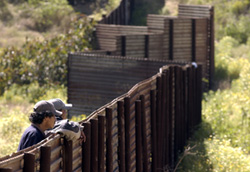| Home | Blog | Ask This | Showcase | Commentary | Comments | About Us | Contributors | Contact Us |

Getting it exactly backwards on immigrationASK THIS | January 29, 2007When it comes to immigration, Princeton University professor Douglas Massey writes that most of what is accepted as true and self-evident by the public and the press about it is patently wrong -- and as a result, policies implemented to control immigration, especially from Mexico, have not only failed, they have backfired. By Douglas S. Massey Q. Is the Mexico-US border really “out of control” in the sense that rates of undocumented migration across it are spiraling upward? Actually, no. The rate of illegal migration from Mexico to the United States has not increased in 25 years and has actually fallen slightly over the past decade. The volume of Mexico-US migration we observe across the border is entirely normal for two countries united by a free trade agreement that seeks to eliminate barriers to the movement of goods, resources, capital, information, and certain categories of people -- investors, intra-company transferees, students, exchange visitors, tourists, and those persons with advanced skills and education. What is abnormal is the militarization of a border with a friendly trading nation that poses no strategic threat to the United States. The probability that a Mexican aged 15 or more will leave for the United States in undocumented status averages around 1% per year, with minor year-to-year fluctuations. That works out to around 720,000 per year. Mexicans constitute around 60% of all illegal immigrants, dwarfing all competitors. The next closest country is El Salvador at 7%, and it trails downward from there. Q. Can the United States really open the Mexico-US border to the free movement of all factors of production while preventing the entry of workers? In other words, is it realistic to integrate all North American markets except that for labor? No. Logically, this desire is self-contradictory because the integration of markets creates multiple connections between persons and social organizations on both sides of the border and these connections naturally lead to cross-border movements of more people. In the course of market integration, nations become more similar to one another as products are standardized, values diffused, languages learned, and cross-border movements become easier and cheaper as transportation and communication linkages proliferate. This logical argument is backed up by the experience of the past two decades. Despite massive increases in the personnel and resources devoted to border enforcement, the rate of undocumented entry has remained relatively constant. There is no evidence of an empirical link between border enforcement and rates of in-migration. Q. Isn’t Mexico a poor country whose population is growing rapidly to produce widespread and abject poverty that fuels migration northward? Although not as wealthy as the United States, by global standards Mexico is a middle income country and is among the better off in the developing world. Its fertility rate has declined sharply in recent years and its population is rapidly aging, leading to labor shortages in many parts of the country. It has a per capita GDP of $10,000 with a life expectancy of 75 years and a fertility rate that at 2.3 children per woman is only slightly above the replacement value of 2.1. Q. Although Mexico’s per capita income may be high by third world standards, is it not true that this figure is still one quarter of the U.S. per capita income and if we do not build a wall along the border millions of Mexicans will come to settle in the United States? No. Evidence indicates that despite the earnings differential, most Mexicans who come to the United States for work do not wish to stay permanently. Rather, they are migrating in order to overcome economic problems at home. Migrants do not come from the poorest and most backward regions of Mexico, but from places that are developing economically with rising wages and employment rates. Development creates needs for capital, credit, and insurance that Mexican markets are still ill-equipped to meet, so Mexicans head north to overcome these market deficiencies. By working in the United States they accumulate savings to finance investments in housing and business in the absence of capital markets; they generate remittances to smooth consumption in the absence of credit markets; and they produce additional earnings flows to diversify sources of household income in the absence of insurance markets. Left to their own devices, the vast majority of migrants historically have migrated to the United States sporadically on short trips and returned to reap the fruits of their efforts in Mexico. Q. If the rate of undocumented in-migration has not changed, what has been the effect of the massive increase in border enforcement over the past two decades? By driving up the costs and risks of border crossing, America’s militarization of the border has dramatically lowered the rate of out-migration back to Mexico. Once they have run the gauntlet at the border and experienced the heightened costs and risks, they are loath to repeat the experience. Rather than returning to Mexico, they hunker down and stay longer, and as they do so they acquire stronger connections in the United States that increase the odds of permanent settlement. Since the border build-up began, the likelihood that an undocumented migrant will return to Mexico within twelve months of entry has been cut in half. Q. If U.S. immigration and border policies lower the rate of out-migration while leaving the rate of in-migration unchanged won’t that increase the rate of net population increase for Mexicans in the United States? Exactly. The perverse effect of America’s unilateral efforts to prevent the inflow of Mexicans during a period of growing economic integration was to increase the number of Mexicans living north of the border in undocumented status. In other words, America’s border policy has backfired and ended up promoting unprecedented growth in the Mexican population of the United States, causing Hispanics to overtake African Americans as the nation’s largest minority more than a decade earlier than demographers had originally forecast. Such is the increase that half of all immigrant Mexicans are now in unauthorized status and one fifth of all Mexican Americans lack the legal right to live and work in the United States.
|
||||||||||||




